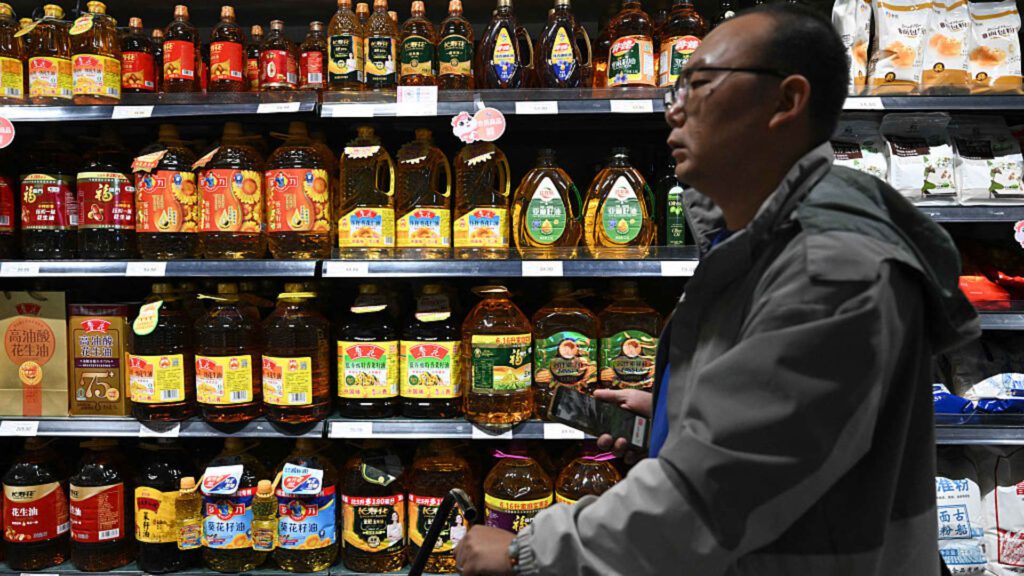A shopper walks past a shelf selling cooking oil at a supermarket in Beijing on October 15, 2025.
Pedro Pardo | AFP | Getty Images
President Donald Trump’s tariffs will cost global businesses more than $1.2 trillion in 2025, with most of the costs passed on to consumers, according to a new analysis from S&P Global.
The company said in a white paper released Thursday that its estimate of additional costs for companies is likely conservative. This price tag is based on information provided by approximately 15,000 sell-side analysts from 9,000 companies that contribute to S&P and its proprietary research metrics.
“The causes of this multitrillion-dollar squeeze are far-reaching. Tariffs and trade barriers act as taxes on supply chains, diverting cash to governments, and logistics delays and transportation costs add to the impact,” author Daniel Sandberg said in the report. “Collectively, these forces represent a systematic transfer of wealth from corporate interests to workers, suppliers, governments, and infrastructure investors.”
In April, President Trump imposed a 10% tariff on all goods imported into the United States and listed separate “reciprocal” tariffs on dozens of other countries. Since then, the White House has entered into a series of negotiations and agreements, as well as adding tariffs on a variety of individual items, including kitchen cabinets, cars, and lumber.
Government officials claim that exporters will be forced to pay higher levies, but S&P’s analysis suggests that is only partially true.
In fact, the company says that, conservatively, only one-third of the cost will go to businesses, with the rest going to consumers. This figure incorporates a $907 billion hit to covered companies, with the remainder going to non-covered companies, private equity and venture capital.
“As real output declines, consumers are paying more for less, suggesting that this two-thirds ratio represents the lower bound of their true burden,” said Sandberg, who co-authored the report with Drew Bowers, senior quantitative analyst at S&P Global.
political and policy interests
The magnitude and cost of tariffs is important both to the White House, which wants to tout tariffs as essential to restoring a fair trade balance, and to policymakers at the Federal Reserve, who are trying to strike the right balance in monetary policy.
“The president and his administration’s position has always been clear: While Americans may face a transition period from the last of the status quo tariffs, the cost of the tariffs will ultimately be borne by foreign exporters,” White House Press Secretary Khush Desai said in a statement.
“Companies are already shifting and diversifying their supply chains in response to tariffs, including reshoring production to the United States,” he added.
Fed officials tend to view the tariffs as a temporary hit to prices and not a source of underlying inflationary pressures. S&P researchers found similar sentiments among analysts.
Consensus expects margins to contract by 64 basis points this year, 28 basis points in 2026, and 8 to 10 basis points in 2027-2028. A basis point is equal to 0.01%.
“2025 is effectively a confirmed blow; 2026 and 2027 will test whether market optimism about rebalancing is justified,” the authors write. “For now, the consensus envisions a world in which margins eventually return to their pre-tariff trajectory. Whether that belief proves justified depends on how companies adapt through technology, cost discipline, and restructuring of the global value chains that defined this cycle.”
The impact is also likely to depend on how President Trump’s tariff strategy develops. The White House is currently facing renewed tensions with China over the rare earth issue and President Trump’s intentions to retaliate.
The S&P paper said President Trump’s removal of the “de minimis” exception for goods under $800 in May was a “real inflection point” for how tough tariffs would become. This exception, which allowed the passage of low-value goods under previous tariff barriers, has become “politically unsustainable.”
“Once the exemption ended, the shock rippled through shipping data, earnings reports, and management commentary,” Sandberg said.
He added: “In the optimistic scenario that this disruption is temporary, the Trump administration’s tariff policies and associated supply chain restructuring are seen as temporary frictions rather than permanent structural taxes on profitability.”


